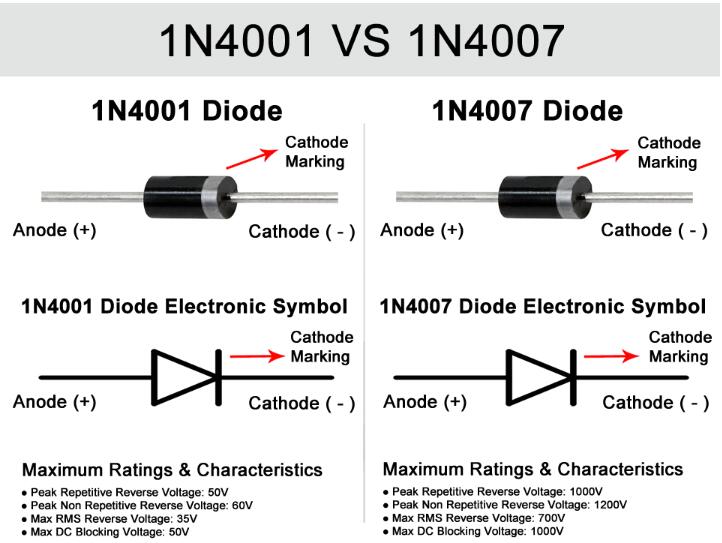The 1N4004 and 1N4007 are both popular general-purpose diodes commonly used in electronic circuits. Although they have similar applications and appearances, there are some important differences to consider when comparing them. Let's explore the dissimilarities, similarities, and interchangeability of these diodes:

Differences:
-
Maximum Reverse Voltage (VRRM): One of the main differences between the 1N4004 and 1N4007 is their maximum reverse voltage ratings. The 1N4004 has a VRRM of 400 volts, while the 1N4007 has a higher VRRM of 1,000 volts. The increased voltage rating of the 1N4007 makes it more suitable for applications involving higher voltages.
-
Peak Forward Surge Current (IFSM): Another distinction is in their peak forward surge current ratings. The 1N4004 typically has an IFSM rating of 30 Amperes, whereas the 1N4007 has a higher IFSM rating of 70 Amperes. The 1N4007 can handle larger surge currents, making it more robust in applications where higher current spikes may occur.
Ratings & Characteristics Comparison:
| Ratings & Characteristics | 1N4004 | 1N4007 |
|---|---|---|
| Max Repetitive Reverse Voltage (VRRM) | 400V | 1000V |
| Average Rectified Forward Current (Io) | 1A Or 1000mA | 1A Or 1000mA |
| Max Forward Voltage (VF) | 1.1V | 1.1V |
| Power Dissipation (PD) | 3 Watts | 3 Watts |
Similarities:
-
Forward Voltage Drop (VF): Both diodes have similar forward voltage drop characteristics. The typical forward voltage drop for both the 1N4004 and 1N4007 is around 0.7 volts. This means that under forward bias, they will have a similar voltage drop across them when conducting current.
-
Forward Current (IF): The forward current ratings for both diodes are generally the same. They are typically rated for a continuous forward current of 1A (Amperes) or 2A, depending on the manufacturer. This means they can handle current flow up to the specified ratings without any issues.
Interchangeability: The 1N4004 and 1N4007 are often considered interchangeable in many low to moderate voltage applications, especially when the maximum reverse voltage and peak forward surge current requirements aren't critical. The higher voltage and surge current ratings of the 1N4007, however, make it a more versatile choice for a wider range of applications.
If you're uncertain about the suitability of interchangeability in your specific circuit or application, always refer to the datasheet provided by the device manufacturer to ensure compatibility and adherence to the desired specifications.
Remember, selecting the appropriate diode for a particular application requires consideration of various factors such as voltage ratings, current requirements, power dissipation, and temperature limitations.


